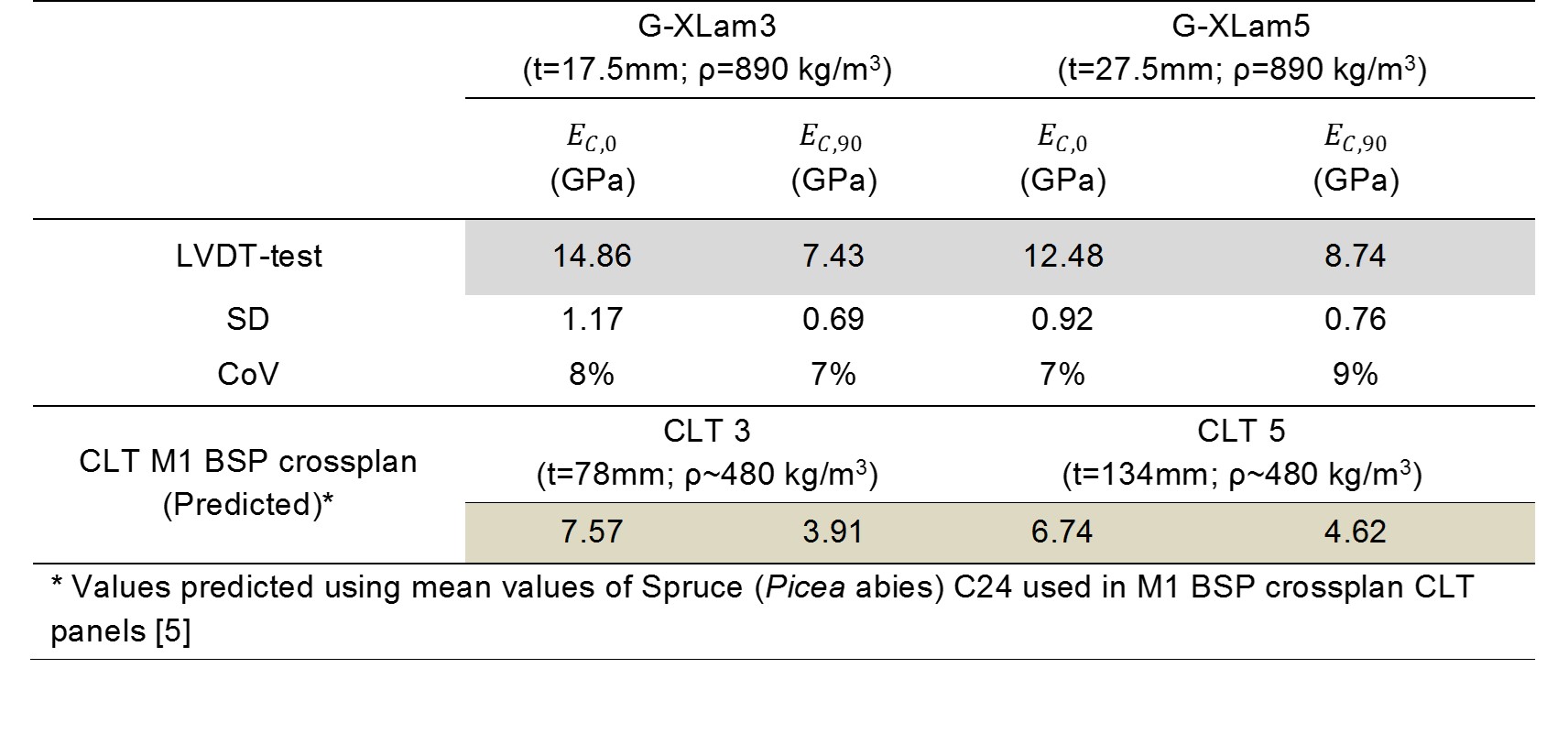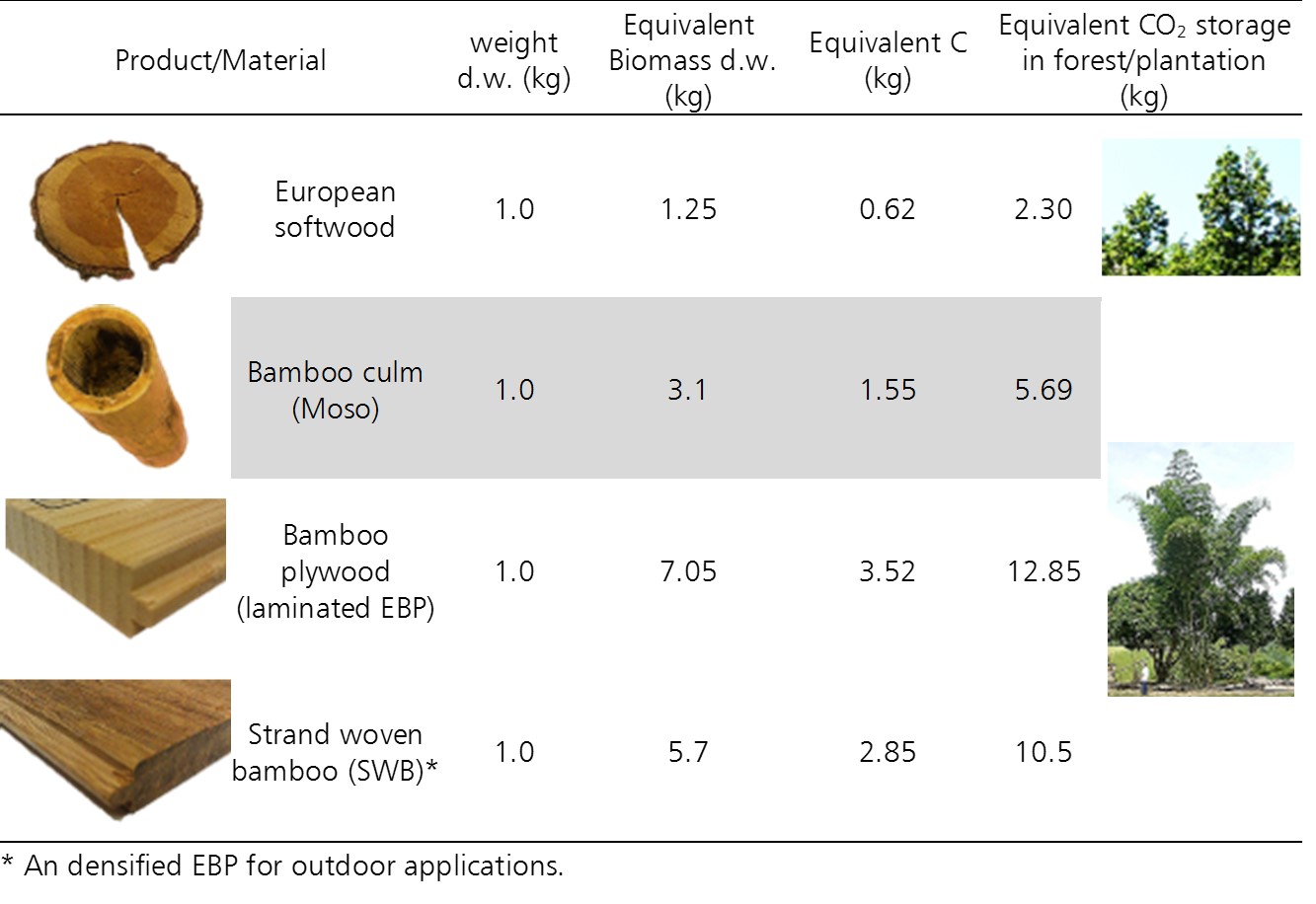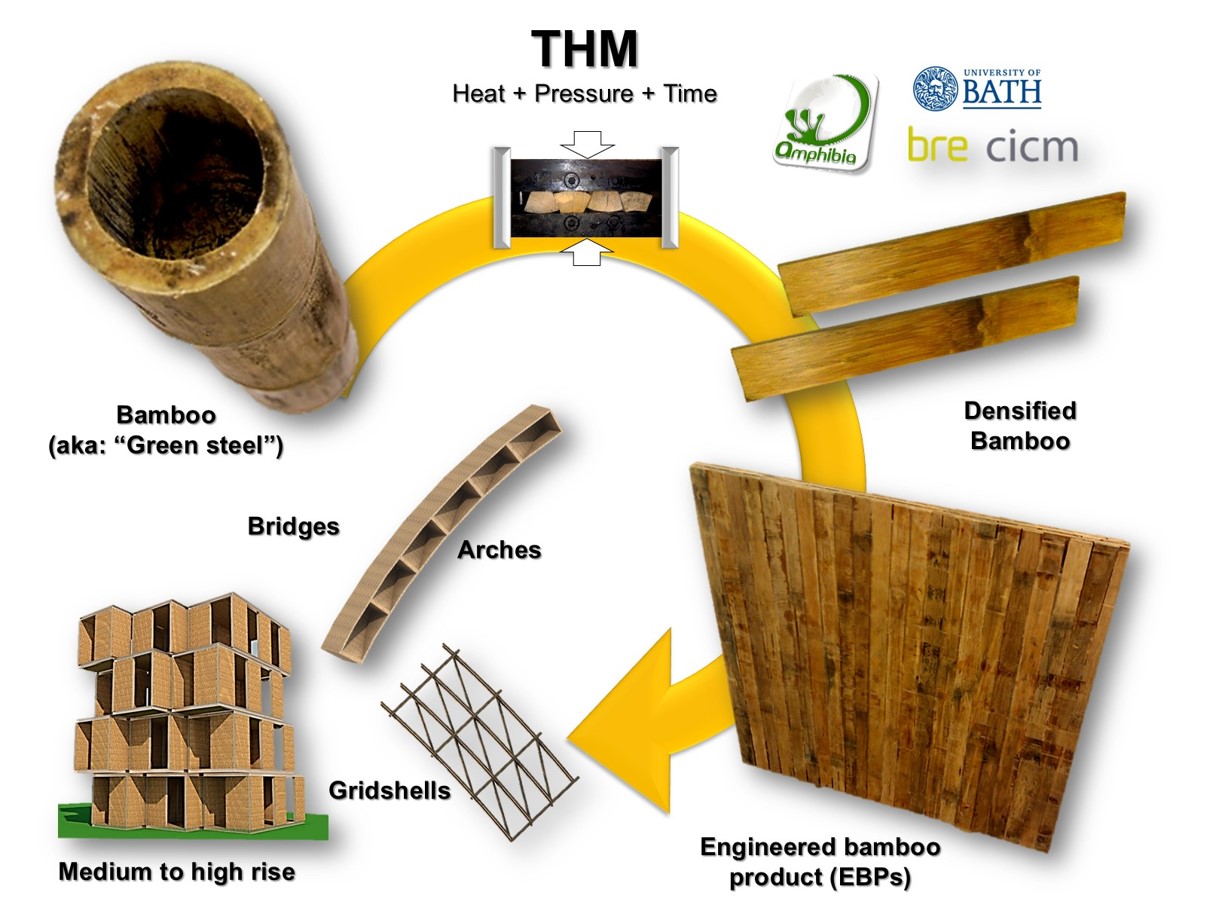Engineered bamboo
Bamboo can be engineered to form products with improved and/or standardised mechanical, physical and aesthetic properties. As in the case for other lignocellulosic materials such as wood, bamboo poles (culms) with variable diameters, lengths and shapes can be transformed into straight edged engineered products with predictable properties for construction applications.
Engineered bamboo products (EBPs) and engineered wood products (EWPs) possess an intrinsic carbon storage capacity, as well as the potential for a lower embodied energy and lower carbon emissions from manufacturing than conventional construction products such as concrete or steel.
For example, the carbon footprint of concrete and stainless steel (304) is two to ten times higher than that of bamboo plywood (a laminated EBP) or an indoor use plywood according to IDEMAT database (2016) [1].
The embodied energy for producing one kilogramme (kg) of stainless steel is almost four times higher than that of producing one kilogramme of plywood [2] or bamboo plywood; 56.70 MJ/kg for the former and 15 MJ/kg and 15.5 for the laminated EBP [1].
Figure 1 illustrates EBP's capability for storing more carbon dioxide (CO2) than the raw and non-processed bamboo culms. There is more CO2 storage equivalent in the bamboo plantation due to the higher use of material per dry weight (d.w.) for the manufacture of EBPs.
Figure 1 Equivalent C02 sequestration in bamboo and wood forest for different bamboo based products. Data from [3].
In addition to bamboo’s remarkable environmental properties and high yield of carbon storing biomass when transformed into durable EBPs, recent research at the University of Bath (UK) has demonstrated potential as a complementary material to wood (rather than a substitute) in structural applications [3].
Cross laminated Guadua-bamboo (G-XLam) panels (Figure 2) developed and tested at the university with the support of British firm Amphibia BASE showed a two-fold increase in density and MOE when compared to analogous cross laminated (CLT) panels (M1 BSP crossplan by Mayr-Melnhof Holz) (Table 1).
That is, the in-plane compression moduli of elasticity of these CLT panels in the main direction (Epc,0) and transverse direction (Epc,90) were about half of that of G-XLam3 and G-XLam5 panels (three and five layers); e.g. Epc,0 was 7.57GPa and 14.83 GPa for CLT3 and G-XLam3 panels.
Figure 2 G-XLam bamboo-Guadua panels for stiffness driven applications
Table 1 Summary of the results obtained from the in-plane compression panel testing and the FE and predicted values previously obtained by [4]
 The thickness of G-XLam3 and G-XLam5 panels is almost a fifth of CLT3 and CLT5 panels (e.g. thicknesses of CLT5 and G-XLam5 were 134mm and 27.5mm, respectively). This is a desirable feature in stiffness driven design but, G-XLam panels possess a high slenderness ratio, which presents a structural challenge in overcoming buckling.
The thickness of G-XLam3 and G-XLam5 panels is almost a fifth of CLT3 and CLT5 panels (e.g. thicknesses of CLT5 and G-XLam5 were 134mm and 27.5mm, respectively). This is a desirable feature in stiffness driven design but, G-XLam panels possess a high slenderness ratio, which presents a structural challenge in overcoming buckling.
Nevertheless, potential engineering applications for G-XLam panels include sandwich panels and stressed skin structures (e.g. monocoques, where thin but very stiff layers are separated by a core or internal structure that increases the second moment of area and reduces buckling.
EBPs such as these G-XLam panels present a new approach to the use of bamboo in structural applications, where bamboo is not seen as substitute, but a complementary material that in combination with wood and/or lightweight cores can provide the required stiffness with reduced cross-sections.
Further testing, research and understanding of the mechanical behaviour of EBPs is required, together with the optimisation of current manufacturing processes and their incorporation within timber standards for structural design.
[edit] Related articles on Designing Buildings Wiki
- Bamboo.
- Bamboo flooring.
- Cedar.
- Click and lock flooring.
- Cross laminated timber.
- Glulam.
- Hex House project.
- Laminated veneer lumber LVL.
- Lime wood.
- Madrid Barajas Airport.
- Modified wood.
- Plywood.
- Skyfarm.
- Softwood.
- Taipei 101.
- Timber.
- Timber vs wood.
- Types of timber.
[edit] External references
[1] Delft University of Technology, “IDEMAT database.” Faculty of Deisgn, Engineering and Production, Delft, 2016.
[2] G. P. Hammond and C. I. Jones, “Embodied energy and carbon in construction materials,” Proceedings of the Institution of Civil Engineers - Energy, vol. 161, pp. 87–98, 2008.
[3] H. F. Archila, “Thermo-hydro-mechanically modified cross-laminated Guadua-bamboo panels,” PhD Thesis, University of Bath, 2015.
[4] H. F. Archila, D. Brandon, M. P. Ansell, P. Walker, and G. A. Ormondroyd, “Evaluation of the mechanical properties of cross laminated bamboo panels by digital image correlation and finite element modelling .,” in WCTE 2014, World Conference on Timber Engineering, 2014, p. 43.
[5] Mayr-Melnhof Kaufmann Group, “Manual Cross-laminated timber panels M1 BSP cross plan,” Austria, 2009.
[6] D. Trujillo and H. F. Archila, “Engineered bamboo and bamboo engineering,” High Wycombe, Buckinghamshire, HP14 4ND, UK, 2016.
Featured articles and news
Government consultations for the summer of 2025
A year of Labour, past and present consultations on the environment, the built environment, training and tax.
CMA competitiveness probe of major housing developers
100 million affordable housing contributions committed with further consultation published.
Homes England supports Greencore Homes
42 new build affordable sustainable homes in Oxfordshire.
Zero carbon social housing: unlocking brownfield potential
Seven ZEDpod strategies for brownfield housing success.
CIOB report; a blueprint for SDGs and the built environment
Pairing the Sustainable Development Goals with projects.
Types, tests, standards and fires relating to external cladding
Brief descriptions with an extensive list of fires for review.
Latest Build UK Building Safety Regime explainer published
Key elements in one short, now updated document.
UKGBC launch the UK Climate Resilience Roadmap
First guidance of its kind on direct climate impacts for the built environment and how it can adapt.
CLC Health, Safety and Wellbeing Strategy 2025
Launched by the Minister for Industry to look at fatalities on site, improving mental health and other issues.
One of the most impressive Victorian architects. Book review.
Common Assessment Standard now with building safety
New CAS update now includes mandatory building safety questions.
RTPI leader to become new CIOB Chief Executive Officer
Dr Victoria Hills MRTPI, FICE to take over after Caroline Gumble’s departure.
Social and affordable housing, a long term plan for delivery
The “Delivering a Decade of Renewal for Social and Affordable Housing” strategy sets out future path.
A change to adoptive architecture
Effects of global weather warming on architectural detailing, material choice and human interaction.
The proposed publicly owned and backed subsidiary of Homes England, to facilitate new homes.
How big is the problem and what can we do to mitigate the effects?
Overheating guidance and tools for building designers
A number of cool guides to help with the heat.
The UK's Modern Industrial Strategy: A 10 year plan
Previous consultation criticism, current key elements and general support with some persisting reservations.
Building Safety Regulator reforms
New roles, new staff and a new fast track service pave the way for a single construction regulator.


























